The pillory square with its 1512 white marble pillar, bearing testimony of the old slavery market and symbol of punishment inflictions is still very much the centre of the local community.
Both rua Banana and rua Carrera are worth a visit, not only because of being historically considered the oldest streets of the whole sub-Saharian African territory, but mostly because the re-constructed whitewashed houses with thatched roofs bear resemblance to the original streets, on which lived quite a few Portuguese and Spanish noblemen in the 15th century, according to historical records.
 Whilst wandering around the area, I came across one of the oldest churches in Cape Verde - Nossa Senhora do Rosário Church, built in 1495. It was initially a gothic style chapel, later extended and its walls covered with tiles. It was unfortunately closed, so I just managed to see it from the outside.
Whilst wandering around the area, I came across one of the oldest churches in Cape Verde - Nossa Senhora do Rosário Church, built in 1495. It was initially a gothic style chapel, later extended and its walls covered with tiles. It was unfortunately closed, so I just managed to see it from the outside.I then decided to walk all the way up the hill to visit the Royal fortress of São Filipe, built in 1587 during the reign of the Spanish King Dom Filipe II , following the devastating attacks by Sir Francis Drake. By the time I got up I was exhausted, but I am glad I did it, otherwise I would have missed some of the most beautiful birds' eye views I have ever seen of Cape Verde.
While walking downhill I came across several children enthusiastically playing with bottle caps on the dirty soil of the hill slopes ... certainly unaware that this soil has witnessed the craddle of a nation ... a nation that goes beyond the limits of its geography and its peoples' difficulties ...













Iolanda, these photos are marvellously beautiful. Thank you for sharing them!
ReplyDeleteI just love it. every time i visit my beloved country i feel like a must to visit our Cidade Velha.
ReplyDeleteLovely
Tnks for the post.